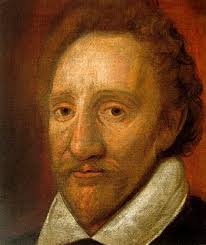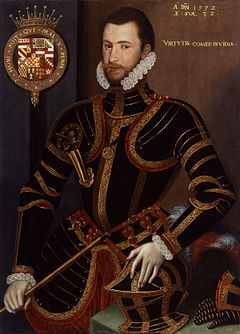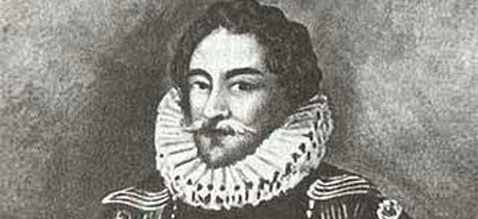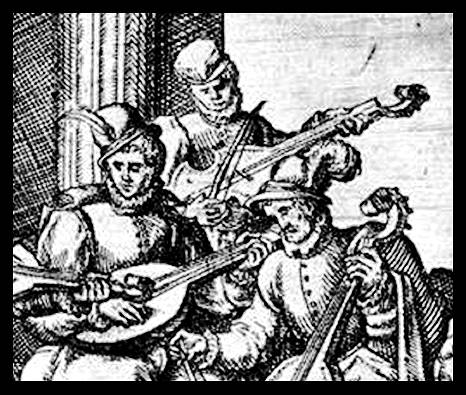Hamlet’s Parallel Universe
William Shakespeare may be “lost in the mists of time”… but Hamlet seems to be ever-living. As a character, he has an uncanny number of parallels with the documented life of Edward Oxenford. Therefore, as long as scholars maintain that William of Stratford wrote Hamlet, other scholars will be asking why the earl has such an overbearing presence in Shakespeare’s greatest work.
Is this really true? That’s me speaking, by the way, circulating my tempered version of a standard Oxfordian claim. Twice in the last three months, I’ve made this assertion in public, and both times I’ve attracted rapid-fire response from scholars who beg to differ. Just last week, Tom Reedy (in the comments section of the Press Telegram) shot back:
I can tell, however, that you don’t know the biographical parallels to the life of James I, Essex, Rutland and Derby that are found in Hamlet, some of which are closer and more abundant that those of Oxford…
Is this really true? A quick survey turns up some intriguing mirrors and allusions (see the links below), some new and some that I’d long forgotten I knew. But are they closer, and more abundant than the parallels to Hamlet claimed for Oxford? Hmmm… How does Tom know this, I wonder? Has someone, somewhere, tabulated these things, a la Diana Price?
If so, I wish that list had come up in the “Parallel Universe” discussion I had with Michael Dobson during his 6-week Hamlet MOOC (massive open online course) this past February. Michael’s immediate response to my Hamlet-parallels-to-Oxford comments echoes Tom Reedy’s:
The category of people with things in common with Hamlet extends well beyond the Earl of Oxford, even if one were to mistake the play for an autobiography.
A few days later, to counter my persistent dragging of a “dead earl” into the picture, he went even further:
…it would be possible to find parallels to almost anyone somewhere in the text of Hamlet if that’s what one wanted to do.
Now surely this statement is truer than true! True, but utterly useless. Shakespeare’s creations continually invite us to wonder and speculate on their glorious specificity. Sensing the inherent weakness of Prof. Dobson’s stance, and even better, the opportunity he’d opened for testing my own assumptions, I countered with a challenge:
I haven’t drawn up my own list of the many parallels – of situation, of temperament, or of plain biographical documented fact – between Hamlet and Oxford, but will happily do so and match them against whatever figure(s) of the times you care to propose, including Richard Burbage. It would be an excellent exercise in critical thinking.
While he didn’t accept my invitation per se, for some reason, over the next few weeks the professor kept answering everything I wrote, so I kept writing, offering more parallels, or responding to his objections with more documentary support for previously cited parallels. Most of his “shoot downs” were superficial dismissals, but one day Michael actually said Something Really Useful:
…if someone kept buttonholing you and asking whether it wasn’t perfectly obvious that Hamlet was all about Philip Sidney – why it even mentions the porcupine, his family crest! he had a powerful uncle! he died of an infected wound! – you’d surely assume that they had a distorting obsession with Philip Sidney that was preventing them from seeing the play, wouldn’t you?
Bingo! That one hit home. Did I have a distorting obsession with Oxford that was preventing me from seeing Philip’s presence in Hamlet? Immediately, I picked up my Variorum edition of the play, and turned to a passage that another student had recently mentioned, (“whilst this machine is to him”) which for some reason had called to mind Oxford’s lifelong foil and Fulke Greville’s hero, Philip Sidney. A day later, after much reading and searching of Sidney’s poems and prose, I found out why – and when I shared one part of my “aha!” moment with Michael, he was gracious enough to admit he found it “truly interesting”. For me, there’s a sweet-n-sour comfort in realizing that both of us may have missed a fascinating allusion by shutting Sidney out of our Shakespearean sights.
Must the establishment of true believers – and by believers I mean those who accept William of Stratford as Shakespeare as well as those who choose Oxford – ignore the evidence of parallels and/or allusions in the text of Hamlet to Essex or Rutland, King James, Derby or Sidney, to protect their candidate? Absent the pressure of authorship contentions, earlier scholars allowed a much wider lens to the author’s hawking eye.
That’s the way I propose to look at Tom Reedy’s four candidates (plus Sidney) for “closer and more abundant” parallels with Hamlet: as if there were no Shakespeare Authorship Question. Shakespeare will simply be Shakespeare, sans quotes or hyphens. For the purpose of this investigation, he’s the author of the Hamlet text we find published in three separate editions: 1603, 1604 and 1623.
Since the play unfolds in time, building on each prior scene, the approach I’ll adopt is to begin with Act 1 scene 1, and examine all proposed allusions or parallels within that scene before proceeding to the next. Each proposed example will require a supporting document. Evaluation will include comparison with Shakespeare’s sources, Saxo Grammaticus and Belleforest, along with other relevant analogues to highlight either the differences or similarities to one or more of these sources.
In my next post, I’ll start with parallels suggested by J. T. Looney in Shakespeare Identified. If you’d like to participate, please join the Facebook group “Hamlet’s Parallel Universe“.
James VI and Hamlet : Lillian Winstanley, Hamlet and the Scottish Succession, 1921
Essex and Hamlet in David Bevington, Murder Most Foul: Hamlet Through the Ages, 2011
Rutland and Hamlet: Ilya M. Gililov, The Shakespeare Game, 2003
Derby and Hamlet: John M. Rollett, William Stanley as Shakespeare: Evidence of Authorship by the Sixth Earl of Derby, 2015
Sidney and Hamlet: George Russell French, Shakespearana Genealogica, 1869







Actually, the biographical allusions to de Vere are in every single play. This argument is long over. Studying de Vere’s life one can see the references from all his teachers throughout the canon, one can know who almost every single character was based on in real life. There is no other candidate who can come anywhere close to these qualifications. In addition, scholarship in the last 30 years has uncovered letters that verify that de Vere wrote under the pen name Shake-speare, which is the authorial attribution, including the hyphen, of the first edition of the Sonnets, the first time the pen name was used. Anyone interested in refining Elizabethan context and understanding what was going on at court, which is where most of the plays were first performed, needs to study de Vere’s life. Yes, we understand that in academia, one advances by regurgitating what they are taught and defending these premises regardless of their factual basis. The same goes for the various bardfests. Tough luck!
@William Ray
William,
Here’s another good one: ‘Who’s th’Heir?
Marie,
I disagree that you can separate these two aspects of ‘Shakespeare’. We have to be sure the text moves in a logical progression from start to finish. The play ends in a contest between the agnatic heir (Hamlet) and the hand picked heir by usurping Claudius. It makes perfect sense to begin with that question — Who’s th’Heir?
The suspect the majority of Oxfordians believe the case for Edward de Vere has been proved beyond a reasonable doubt. It would be disingenuous for most of us to pretend we are not satisfied with the evidence. A ‘rigorous methodology’ can never be rigorous enough for many. Some of us want to move on to The Real Question: What the hell is this guy trying to say? As you have said yourself, by understanding his words, the Authorship Question will answer itself.
Mike: My apologies; I thought I’d approved this comment when it first came in, and just realized it was still sitting in queue. Yes, I agree (I think) about logical progressions from start to finish. But the project isn’t geared to solving the authorship question, or answering “what the hell is this guy trying to say?” Tabulation of suggested parallels, correspondences, topical allusions, etc, is what this is about. An interpretation of “Who’s there?” as “Who’s th’ Heir?” doesn’t fall into the category of parallel or allusion. As for the majority of Oxfordians believing that their case has been proven beyond a reasonable doubt, perhaps this project will not seem necessary to them. Personally, I don’t feel that the theory has been proven, or that it can be proven beyond a reasonable doubt, not with the existing evidence. A leap of faith is necessary.
Dear Marie,
I do not have the background indicated by the above remarks’ content, but in terms of starting at the beginning of the play, the question, “Who’s there?” can be interpreted another way, a punning declaration of origin, “(w)Ho’s there”. “Ho” being pronounced “Oh” in Italian and appearing in the Lucrece epistle introductory FOUR times. Ergo, “O’s there.” It answers the first actor’s question, who’s there.
I believe the sound “Oh” has personal authorial meaning from the point of view of an Oxfordian authorship. As potential confirmation, when we go to the last utterance the protagonist Hamlet makes, we find another repetition of the sound “Oh”: “O O O O” (dies). Four “O”s. Four/vier/Vere times O(xford). Four,forty, and O are ubiquitous numbers throughout the canon and the author starts right off with the sound.
Hi Bill, thanks for your comment – and for obliging me by starting at the beginning! However, I don’t think this type of linguistic analysis that you and Mike enjoy pursuing falls into the same category as a biographical or topical parallel. This project aims to discern and tabulate actions, situations and dialogue within the play that parallel documented events in the lives of persons whom Shakespeare could have known or been aware of. Since I do think there’s some relevance to the repeated “O, O, O, O” in one of the versions of Hamlet, I’m still looking to see where this type of analysis can fit within a much more rigorous methodology. If the validity of a reading depends upon the assumption that Oxford is the author – as your first idea does – that will decrease it’s value to this project. We’re starting from a pre-SAQ position, with Shakespeare as author.
@Marie Merkel
Marie,
I think you should give your Alphabet a longer leash. Why not give it free rein? See where it takes you. Establishing limits to Shakespeare’s wordplay and ambiguity is dangerous. Let the artist establish his own limits.
Obviously, we advocate different degrees of attention to detail in reading. Shakespeare’s works are rewarding on several levels, and surface readings are great for the pace of performance; but there is political dissidence at play and a lot of secrecy that can only be discovered at a snails pace. Overlook it if it pleases you.
Sorry for jumping ahead. I’m not a good rule follower.
Shakespeare’s Alphabet, 3rd Technique: ‘Split persons’ at Hamlet l.5 17-19
GHOST
17 – “Thy knotted and combined locks (hairs/heirs) to part (divide, L. di-videre, di: ‘double’ + videre: ‘see’, hence ‘See double’),
18 – And each particular (L. proprius: ‘one’s own’) heir to (Tu) stand an end (wp endure, end-dur, or end in ‘dur’; hence Tu-dur). Note: “stand AN end (‘tolerate an end’), not ‘stand on end’.
19 – Like quills (L. spina: ‘thorns’) upon the fearful (L. timidus) pig-spiny (porcus-spina).” This last line clarifies how ‘spina’ is to follow ‘porcus’, just as ‘dur’ is to follow ‘to’ in line 18.
You don’t have to read Latin to enjoy the stories of ‘Shakespeare’. They work nicely on an apparent level; but if you want to get the inside story, Latin dictionaries are necessary. Don’t you wish they had pushed it more in the school curriculum.
The Sidney mascot was the Porcupine, but the ‘quilled pig’ may indicate a Boar-ish writer.
Many times have I regretted coming of age just as Latin was pushed out of High School. And I do think that individual words with potential puns or other wordplay will hint at “split persons” within the text, often just for the one line or passage. It’s the dramatist’s sly technique for slipping in cues to the actor or reader that there’s a topical allusion at hand. Thanks for these further observations, Mike, but again, we’re looking at Act 1, scene 1. right now, with Bernardo, Marcellus and Horatio encountering the Ghost.
Great subject Marie,
I’m still hard at work on Titus, but this is good Tu.
The ghost might be Sir Henry Sidney, father to Philip Sidney; did he commit “foul crimes done in [his] Days of Nature’ (Ham l.5 12)? Nothing that should confine him “to fast in fires,” (l.5 11) I think.
Now, Sir Thomas Seymour … he was accused of trying to marry Princess Elizabeth without the consent of Parliament or the Privy Council. ‘De’s (Latin ‘Origins’) of Nature’ suggests illegitimate or natural children?
“I could a tale (an entailment, attainder) unfold whose lightest word” (l.5 15) … what is the lightest (smallest) word of the word ‘word’; it’s ‘Or’ right? That would also support Seymour’s candidacy, because ‘Or’ or ‘Ore’ or (Latin) aurum means ‘gold’ and is the common syllable of Tu-d’or and Seym-our. Is our writer identifying the mother of his ‘natural’ child as a Tudor-Seymour?
” … Would harrow up thy soul”; ‘harrow’ is (Latin) torquere, meaning to twist or turn, or (Latin) verso. I sense were getting close to the writer’s game. He means Vere-So (Vere-Sea-Mor; as I’ve mentioned many times, Welsh mor = ‘so’ and ‘sea’).
How about: “Make thy two eyes like stars start from their spheres”. When I see the word ‘two’ or ‘too’ in Shakespeare, I jump, and so should Tom Reedy. Two what? “Two eyes” — read ‘Two orbs’, (Latin) orbis, meaning literally ‘of the eye’. Now play with that little ‘orbs’ like a true lover of Shakespeare … ‘dors’, right? Twod’ors? Check out your dictionaries, he means:
“Compel your Tudors like [the] Stars (astrological) Spring from their Magistracy”. He’s talking about a change of name and a change in divination, from Tudor to something Spring-ish or Ver-ish.
There’s a lot More. It’s always the Same game … Almost.
Hi Michael, Thanks for the comment. Right now, the focus is on Act 1, scene 1, so it’s too soon to look ahead to what Hamlet and the Ghost say to each other. I’m sorry to say I don’t agree with your method of “harrowing” Shakespeare’s words until you’ve changed the surface meaning entirely. I don’t think Tom Reedy or anyone else should jump when they read the word “two” in his texts – or read the word “orbs” in “eyes” and then come up with “Tudor”. In the first place, who called the Tudors Tudors at the time? Second, if Shakespeare meant “orbs”, why bother with “eyes”? I cannot accept that the author was so very contemptuous of his readers and audience that he would write lines that had no worthy meaning until we’d changed every other word to something else. You have taken his “every word doth almost tell my name” in one sonnet and given yourself license to apply everywhere.
But beyond that, for this project, authorship claims must remain in the background, with no one candidate favored. Even if we had proof that Thomas Seymour was Edward de Vere’s father, you’d need to offer documentary support that parallels the context and/or language of Shakespeare’s text as written, for whatever passage you perceive a parallel with Seymour. I’m not so simple as to deny wordplay, Latin or other inter-lingual games, puns, etc. But we’ve got to first trust that the poet wants us to take him at his word.
On a side note, I’ve written several posts on the question of Oxford being a bastard. See my review of Beauclerk, “Much Virtue in If”, for the main thrust of my argument against the Seymour-Elizabeth theory. Within that post, you’ll find links to the other blog entries. Hopefully, they will work properly; I’ve had some trouble after neglecting the site for the past year.
The best place to start here is Abel Lefranc’s essay in “A La Decouverte de Shakespeare”. Lefranc followed up on Winstanley and found that she had passed up an absolutely crucial reference which clinched her case.
Belleforest in his version of Hamlet (“Histoires Tragiques” from which everyone agrees Shakespeare directly drew) specifically listed a series of parallels between his Hamlet and the murder of James’s I (or VI’s) father. Lefranc takes this even further by elaborating similar structural parallels with Kyd’s “Spanish Tragedy” and thus again back to “Hamlet”.
The Oxford link is also obvious as Catholic Oxford was forced, as proof of his own questioned loyalty, to sit on the commission that condemned Mary to death. The claim that he wanted the verdict set aside may or may not be an Ox myth. But common sense should tell us that he wouldn’t have appreciated the situation in which Elizabeth placed him.
Re Rutland: Check Celestin Demblon’s “L’Auteur de Hamlet and son Monde”, 1914. Demblon devotes a large part of his argument to tracing Quarto 2 Hamlet parallels (not found in Quarto 1) to the report of the Rutland embassy to Denmark. He also notes that Rutland studied law at Padua with fellow students Rosencrantz and Guildenstern in 1598. And he could have gone even further by pointing out that Francis Meres shortly after publishing Palladis Tamia ended up as a schoolmaster in the vicinity of Belvoir Castle.
Re King James: King James would have been anything but pleased to be reminded of his mother’s alleged murder of his father. So much for James as Hamlet and [Henry Neill] Paul’s chimerical Shakespeare’s “Royal Play of Macbeth”.